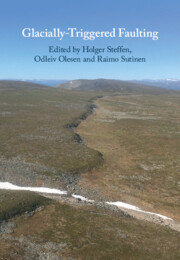Book contents
- Glacially-Triggered Faulting
- Glacially-Triggered Faulting
- Copyright page
- Contents
- Figures
- Tables
- Contributors
- Preface
- Part I Introduction
- Part II Methods and Techniques for Fault Identification and Dating
- Part III Glacially Triggered Faulting in the Fennoscandian Shield
- Part IV Glacially Triggered Faulting at the Edge and in the Periphery of the Fennoscandian Shield
- Part V Glacially Triggered Faulting Outside Europe
- Part VI Modelling of Glacially Induced Faults and Stress
- 22 Glacial Isostatic Adjustment Models for Earthquake Triggering
- 23 Crustal-Scale Stress Modelling to Investigate Glacially Triggered Faulting
- Part VII Outlook
- Index
- References
23 - Crustal-Scale Stress Modelling to Investigate Glacially Triggered Faulting
from Part VI - Modelling of Glacially Induced Faults and Stress
Published online by Cambridge University Press: 02 December 2021
- Glacially-Triggered Faulting
- Glacially-Triggered Faulting
- Copyright page
- Contents
- Figures
- Tables
- Contributors
- Preface
- Part I Introduction
- Part II Methods and Techniques for Fault Identification and Dating
- Part III Glacially Triggered Faulting in the Fennoscandian Shield
- Part IV Glacially Triggered Faulting at the Edge and in the Periphery of the Fennoscandian Shield
- Part V Glacially Triggered Faulting Outside Europe
- Part VI Modelling of Glacially Induced Faults and Stress
- 22 Glacial Isostatic Adjustment Models for Earthquake Triggering
- 23 Crustal-Scale Stress Modelling to Investigate Glacially Triggered Faulting
- Part VII Outlook
- Index
- References
Summary
Modelling of stresses that influence glacially triggered faulting has progressed substantially in the last decades with more complex models and improved modelling techniques, incorporation of a variety of relevant processes, better constraints of ice-loading history, higher model resolution and 3D geometries. Some recent developments are collected in this section to portray the scope and variability of numerical modelling relevant to glacially triggered faulting. These range from modelling of the general in situ stress field to studies on the stress field induced by glacial loading and unloading.
An appropriate estimation of the ambient background stress field is crucial for determining the effect of additional ice loading (or unloading) on pre-stressed faults. Contributions from local and far-field stress sources (topography, tectonics) need to be reconciled with in situ measurements from boreholes and fault-plane solutions from earthquakes. We describe the different types of stresses in glaciated regions with a focus on Scandinavia together with the techniques used to incorporate stresses into numerical models.
Keywords
- Type
- Chapter
- Information
- Glacially-Triggered Faulting , pp. 402 - 416Publisher: Cambridge University PressPrint publication year: 2021
References
- 1
- Cited by



